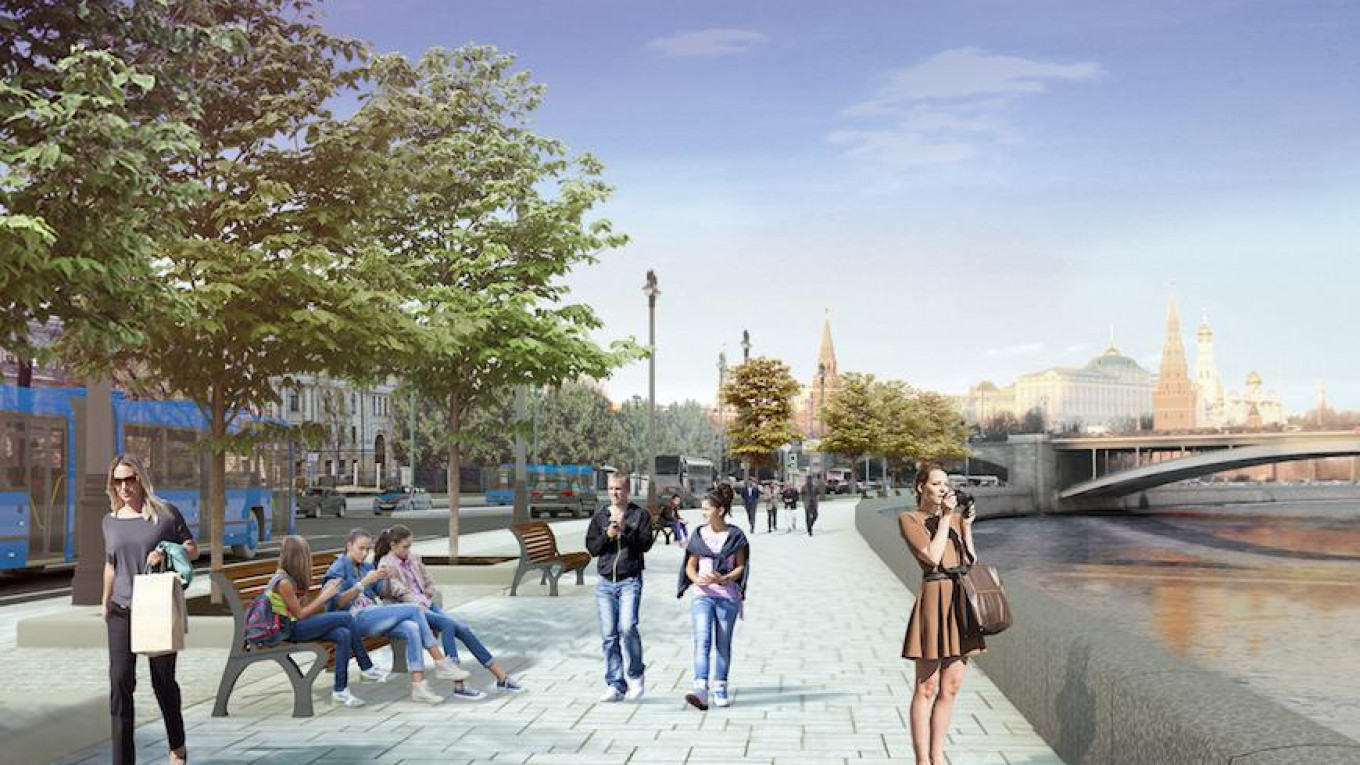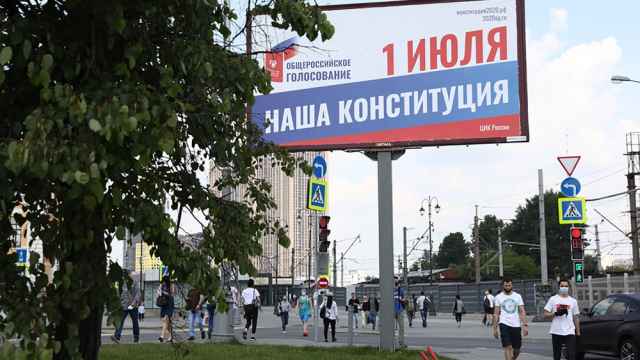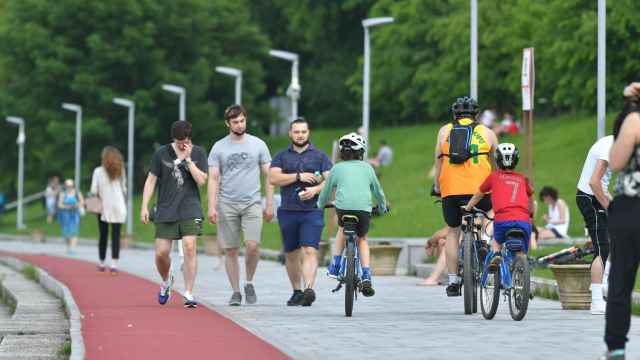When it comes to renovation, Moscow authorities take no prisoners.
Every summer since 2015, they’ve been launching sweeping roadworks across the city center, reshaping dozens of streets, squares and public places. Relentless digging, paving and painting usually starts in April and ends in September.
Nothing can deter it: neither Muscovites’ raging complaints about the traffic jams it causes, nor newly repaired streets getting flooded by rain because of defective drainage. Not even bloggers, insinuating that replacing the tiles installed several years before is merely an attempt by officials to “take advantage of the budget,” can stop it.
In 2015 and 2016, Moscow authorities renovated 106 streets. This year, City Hall plans on doing the same for another 87 streets, squares and public spaces. The program, called “My Street” and posted on the City Hall website, calls it “the biggest renovation program in Moscow’s modern history.” The project is supposed to be completed in 2018, right in time for the mayoral elections and the World Cup.
Its scale and ambition suggest it would quite significantly alter the face of the city. But will it be a change for the better?
Before and after: Lubyanka, the Moscow square accommodating the headquarters of the FSB, the notorious KGB successor, is set to become a pedestrian zone with benches, trees and maybe even a fountain.
Good on paper
Moscow authorities developed the program together with the prominent architectural bureau Strelka, well-known for its sophisticated, hip projects. Its pictures of what Moscow’s streets and squares will look like after this year’s renovation show a lot of promise.
Take Lubyanskaya Ploshchad, the Moscow square that accommodates the headquarters of the Federal Security Service (FSB), Russia’s notorious KGB successor. Currently a giant roundabout with intense traffic, it will become a pedestrian zone with benches and trees. According to Strelka’s spokespeople, the project also includes a fountain in the middle of the square, but deputy mayor Pyotr Biryukov, the City Hall official in charge of renovation, says it is “technologically impossible.”
Trees and benches will also replace cars on Ploshchad Tverskaya Zastava, adjacent to the Belorussky train station. For years, it has been off limits to Muscovites: In 2007, city authorities approved the construction of an underground shopping mall there — a typical project under then-mayor Yury Luzhkov. By the time the authorities reconsidered the decision in 2011, the square had turned into a construction site. It was only recently opened — as a parking lot.
The renovated Ploshchad Tverskaya Zastava will get its main attraction back — a monument to the Soviet writer Maxim Gorky, installed there in 1951 and moved to the Muzeon Park in 2005. In addition, a tram line that existed there in the early 20th century will return to the square.
Before and after: Krasnye Vorota, a square adjoining the Garden Ring in the North-East of the city center, will get a complete makeover. Moscow authorities promise to turn it into a grove with various types of trees and hills.
Another square set to get a complete makeover is Ploshchad Krasnye Vorota, adjoining the Garden Ring in the northeastern part of the city center. Until recently it was filled with kiosks and small shops, but they were demolished in last year’s controversial effort to get rid of unauthorized retail pavilions. Moscow authorities promise to turn it into a grove with various types of trees and hills.
The project will create more space for pedestrians around the Kremlin too: Ulitsa Varvarka will become completely car-free. The adjacent Birzhevaya Ploshchad, mostly used for parking, will get a fountain and trees. These new spaces will “frame” the Zaryadye Park — another grand project from Moscow Mayor Sergei Sobyanin — scheduled to open in September. After five years of construction, it will finally fill the gigantic void near the Kremlin, left after the famous Rossiya hotel was demolished in 2006.
The area around Ulitsa Volkhonka — famous for its proximity to the Pushkin Fine Arts Museum and several other museums— will turn into a “Museum Block.”
In addition, twelve river embankments — including Krasnopresnenskaya, Smolenskaya, and Bolotnaya — will be renovated. Sidewalks will be widened and adorned with trees and benches. As a result, embankments will become “a unified promenade area,” the City Hall’s official website promises.
The seamy side
A closer look at how renovation was carried out last year indicates that this beauty will be steamrolled upon Moscow in the usual “no retreat, no surrender” style.
City Hall spends a fortune on renovation. Moscow Mayor Sergei Sobyanin dismisses accusations of wasting money on benches at a time of economic crisis, saying that this is an investment in Moscow’s future income from tourism.
It is still unclear how much the 2017 renovation will cost the city budget. According to deputy mayor Biryukov, not all tenders have been conducted yet, which makes it impossible to calculate a total. However, the RBC news website’s analysis of finalized tenders suggests that this year 15.3 billion rubles ($271 million) will be allocated to works on the Garden Ring and Boulevard Ring alone — 30 percent more than last year.
According to economist Natalya Zubarevich, renovation expenses grew by 26 percent between January and September 2016. “Renovation funding is now better than funding for schools, which dropped by 27 percent,” Zubarevich wrote in a column for the Vedomosti business daily in December 2016. “They never asked for Muscovites’ [opinion].”
Not caring too much about peoples’ opinions seems to be the Moscow authorities’ modus operandi.
Before and after: Prechistenka, Moscow’sprestigious Golden Mile, is set to gain wider sidewalks as part of a pedestrian-friendly makeover.
Prominent Moscow architect Yevgeny Asse says he and his team participated in developing one of the projects, but had to drop out due to dissatisfaction with the way it was being implemented. “I know several foreign architects who were also unhappy with the way their projects were being carried out,” he says. “There were lots of [other] issues with contractors, materials, and customer preferences.” The latter is, naturally, City Hall.
Alexandra Sytnikova, partner at the Strelka consulting bureau, echoed his sentiment. “Not all of our solutions were fully implemented [last year]. For instance, the customer decided to install stair rails on the Novy Arbat street that were different from our project. We can’t say we fully agree with their design solution,” Sytnikova told The Moscow Times.
When it comes to dealing with cultural heritage — somewhat inevitable in the center of Moscow — authorities don’t listen to opposing opinions either, says Konstantin Mikhailov from architectural preservation group Arkhnadzor.
Last year, during renovation projects in several areas, ancient stone-work found under the asphalt was damaged by workers. This year, Arkhnadzor specialists met with officials from Moscow’s cutural heritage department and suggested inviting archeologists to oversee the works in 2017. Officials agreed, but in reality nothing changed.
“The work has just started on Novaya Ploshchad, and they already damaged part of the ancient Kitai-Gorod wall,” Mikhailov told The Moscow Times. “The rush to finish the renovation in time outweighs everything else.”
This rush also steals summer from Muscovites, adds Asse. “They usurp Moscow during the summer, at a time city residents are eager to spend walking and enjoying the city. Instead, Moscow is turned into hell. It’s only April now, and already you can’t get through the boulevards.”
Before and after: Varvarka, a small nondescript street leading right to the Kremlin, will become a tourist zone. It will frame the utopian Zaryadye Park, another of Moscow’s grandiose projects.
The bottom line
Once the dust settles, it becomes clear that the renovated streets look disappointedly similar. They lose their individuality, says Asse. The same architectural elements are used, the same means, the same concepts.
Often, the quality of the work is low too. Pavements quickly deform, the drainage system gets clogged, and some streets can’t be walked on because of giant puddles created by the rain. “Far from every [contractor] who takes on this work actually understands how it should be done,” Asse told The Moscow Times.
Sobyanin’s style is generally better than that of his predecessor Luzhkov’s, the architect admits. “Luzhkov’s style featured bad taste and vulgar beauty. Sobyanin’s team works with some very good architects and doesn’t entertain bad taste,” he says.
However, nothing stands out about this style, either, according to Asse. “It’s not remarkable. It’s just not appealling.”
Muscovites polled by The Moscow Times admit the city center looks better after last year’s renovation works: “more like Europe,” “more pleasant for pedestrians” with its wider sidewalks and softer lighting. For many, however, it’s not about beauty — it’s about the practical aspects.
“It takes me an hour and a half to park the car [in the center] now after they expanded pedestrian zones. I tried using public transport — but with two children in a baby carriage it’s impossible to cross the Garden Ring. Ramps in newly renovated underpasses are too narrow for a carriage. Who did they make them for?” says Maria, a mother of two.
“Wide sidewalks are great, really!” agrees another Maria. “But their quality is so poor that the tiles installed last year are already ruined. In addition, new sidewalks don’t have drains, so during winter they’re covered with black ice. I wouldn’t want to grow old in this city.”
A Message from The Moscow Times:
Dear readers,
We are facing unprecedented challenges. Russia's Prosecutor General's Office has designated The Moscow Times as an "undesirable" organization, criminalizing our work and putting our staff at risk of prosecution. This follows our earlier unjust labeling as a "foreign agent."
These actions are direct attempts to silence independent journalism in Russia. The authorities claim our work "discredits the decisions of the Russian leadership." We see things differently: we strive to provide accurate, unbiased reporting on Russia.
We, the journalists of The Moscow Times, refuse to be silenced. But to continue our work, we need your help.
Your support, no matter how small, makes a world of difference. If you can, please support us monthly starting from just $2. It's quick to set up, and every contribution makes a significant impact.
By supporting The Moscow Times, you're defending open, independent journalism in the face of repression. Thank you for standing with us.
Remind me later.






